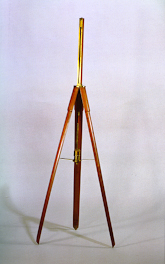
143.5
Brass, wood and glass
CAT. 1851 : 20.D.IV
Dois barometros construidos em Londres por J. J. de Magalhaens. Cada um d´elles
é munido de um estôjo de madeira dividido em trez partes para lhe servir ao
mesmo tempo de tripeça.
Two barometers constructed in London by J. H. de Magellan. Each one of them is provided with a wooden case divided into three parts which serves at the same time as a tripod.
The collection of instruments in the Gabinete de Física in Coimbra has been enriched by two examples of barometers, described by J. H. de Magellan in his work Description et Usages des Nouveaux Baromètres, pour Mesurer la Hauter de Montagnes et la Profondeur des Mines, which were manufactured in London by William and Samuel Jones.
In his article, Magellan pays homage to the famous Torricelli, friend and successor of the great Galileu. Torricelli was the inventor of the barometer, which spread rapidly all over Europe. After its invention, English scholars and inventors strove to perfect this measuring instrument.
This model of barometer was characterised by its performance when transported, being observed to be sufficiently precise according to the results of experiments that were carried out. Magellan, a profound expert of English manufacturers of scientific instruments, refers to it as being of the best quality known at the time.
For use, the barometer is mounted on a wooden tripod that also serves as a carrying-case when the barometer is transported. On the upper part of the tripod there is a ring articulated about a horizontal axis. This ring is almost elliptical in shape, exhibiting two grooves in a V shape, facing each other and situated over the narrowest part of the diameter of the ellipse. These support the two metal strips carefully placed in the middle of the wooden frame that protects the barometer's glass tube.
For its transportation, the barometer must be slightly raised, after making a 90 degree rotation, so that the metal strips can pass through the supporting ring. Thanks to this operation, the apparatus was protected inside the three legs of the tripod, kept closed by two rings that encircled them. The apparatus has a calibrated scale on a brass plate in order to read the height of the column of mercury. This scale is fixed in the wooden frame that protects the glass tube.
For precise readings there is a micrometer that moves along the main scale.
Magellan, John Hyacinth, Collection de Différents Traitès sur des Instruments D'Astronomie, Physique, etc., London, 1780, pp. 87-164, Pl. V, Fig. 39 and 41.